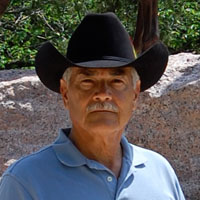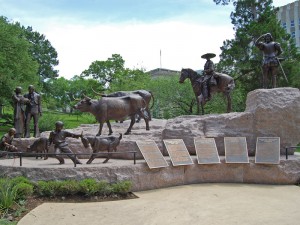Tejanos are the original cowboys who farmed and ranched Texas lands 130 years before the emergence of the iconic American cowboy. Dr. Andrés Tijerina, professor of history at ACC, has made it his personal mission to spotlight the Tejanos’ little-known role in Texas history.
Tejanos were Mexican and Spanish descendants who inhabited the territory they called Tejas long before U.S. and European settlers arrived. Tejanos fought for and won their independence from Spain and, later, Mexico. They also created an entire culture that influenced the cowboy culture that prevails in Texas even today. Dr. Tijerina helped found a committee of dedicated individuals who worked for more than a decade to raise funds and gather support for a Tejano monument to be placed on the grounds of the Texas Capitol.
That day finally happened on March 29, 2012. Tijerina gathered with other supporters at the entrance to the Capitol to dedicate the monument honoring the contributions of Tejanos.
Tijerina recently discussed the Tejano Monument and how today’s Latino students continue to shape history in Texas and the United States.
How did this idea originate?
In 1998, I presented a speech about Spanish Colonial Texas at the University of Texas-Pan American. I mentioned many things that I still say today about Texas-Tejano heritage. I talked about how Mexicans and Spanish descendents were the first to inhabit Texas; they built the economy through agriculture and cattle. Their heritage is everywhere, from the diet that includes flour tortillas and beef jerky to the language that incorporates words like “rodeo” and “lazo.”
By the end of the speech, Calletano Barrera and Enrique Guerra approached me and instilled the idea of a statute representing the Tejano heritage. As a result, we formed The Tejano Monument, Inc., along with with Homero Vera and Richard Sanchez.
After several years of brainstorming, we approached the Texas Legislature in 2000 and asked them to pass a bill to authorize us to design, raise funds, and put up a monument that would represent Tejano heritage.
How did you select the artist?
The Texas Commission on the Arts, with then-Executive Director Rick Hernandez, provided guidance and helped conduct a nationwide search for an artist. Five finalists produced miniatures of their proposed statues. One of the entrants, Armando Hinojosa, envisioned not just a statue. Instead, he designed a monument, or a group of statues. We liked his idea and selected his proposal.
What does the statue mean to you?
It is not only the realization of a dream – it also embodies the scenes that I put into my U.S. history classes. I try to talk about Tejanos, women, people of color, and other themes that are usually not written in history textbooks.
How do Latinos of today relate to the Tejano Monument?
They are part of the Tejano Monument because they were immigrants, too – not just the ones who arrived yesterday. All of us are part of it. If Latinos want to be Americans, they need to be become citizens, they must vote, and they must shape the government of Texas and the government of United States. Unless they incorporate themselves into the community, the government, and politics, they are condemning themselves to be immigrants forever. We do this to let everyone know that las puertas estan abiertas (the doors are open). We need to become Tejanos; “Yo mismo me hice Tejano” (I myself became a Tejano).
How can students exhibit those lessons in their lives?
As a child of illegal immigrants, I couldn’t go to school year-round. I picked cotton at the age of 6 and would go to school six months out of the year. When I did go to school, I did my best to catch up. We were labeled as “Mexicans” and couldn’t go into the city; we were not allowed. The barriers that students face today are quite different compared with what we faced.
Here is the formula for success: You determine not to reflect the system; guide, change, and take command of the system. Take command of your own education. Do not go to the teacher and ask them to teach you. You go up to the teacher and tell them to teach you!
I know that a lot must be done – but go and demand to learn. This is what I tell my students at ACC.
For more from Dr. Tijerina, read his essay in the Austin American-Statesman.
Back to Top



By Lesli April 26, 2012 - 8:23 pm
That is great for all of us Texans! my understanding is that Tejanos also influenced what are today called Paniolos (Hawaiian cowboys)!
By Joe L. Mireles June 5, 2012 - 1:40 pm
Dr. tijerina,A group of concerned Tejanos are trying to make a difference here in Port Lavaca Tx. We are a handful of people that are interested in introducing the true history of our culture. We feel that Tejano history has been hidden from us for to long. That those who call themselves the majority will always be above us. And we feel that by re-educating our culture, our people will see the light. Oppresstion by degrading us has been the norm. Especially here in Texas. I would appreciate your comments to what we are trying to accomplich. Thank You Joe L. Mireles